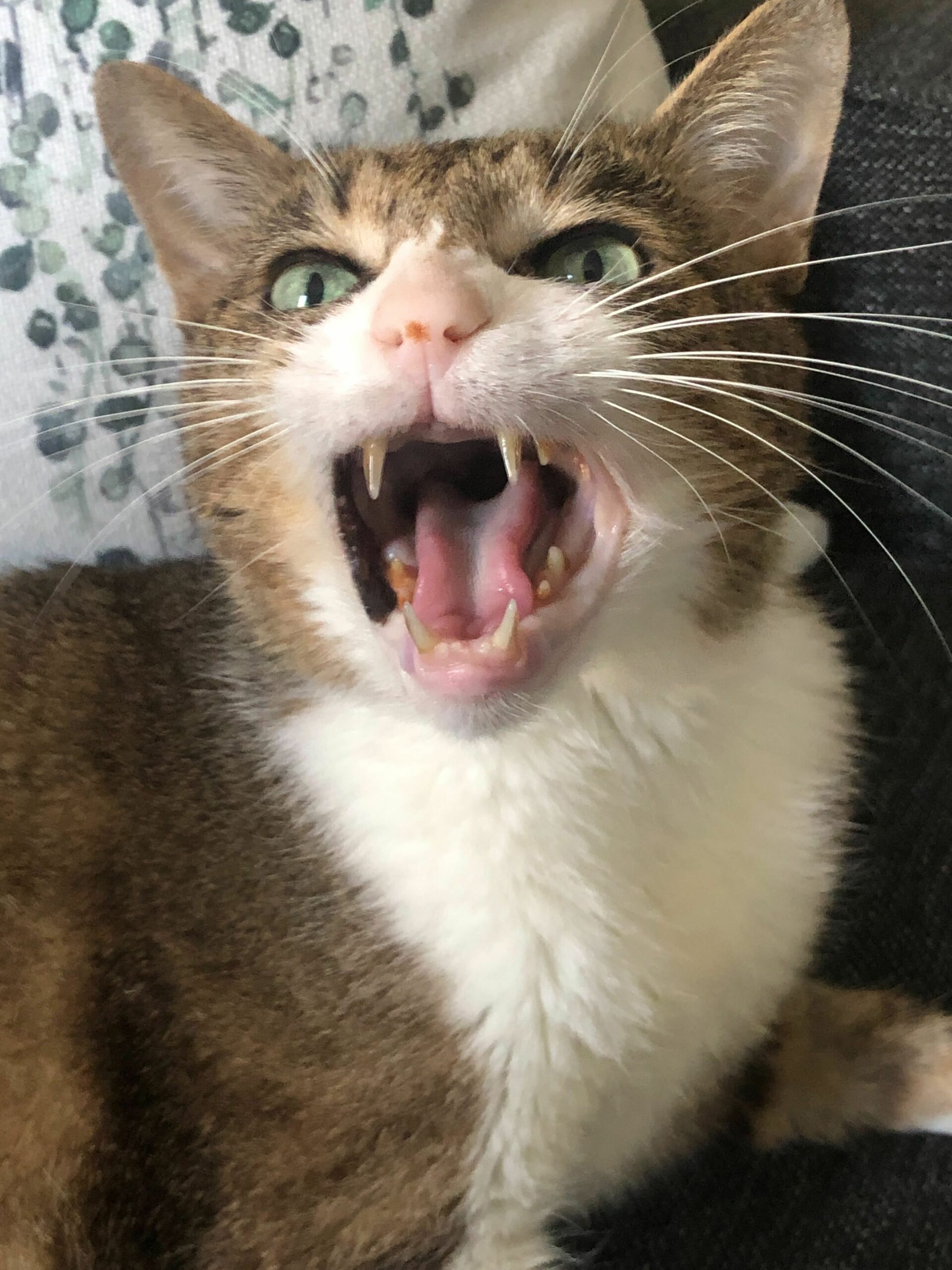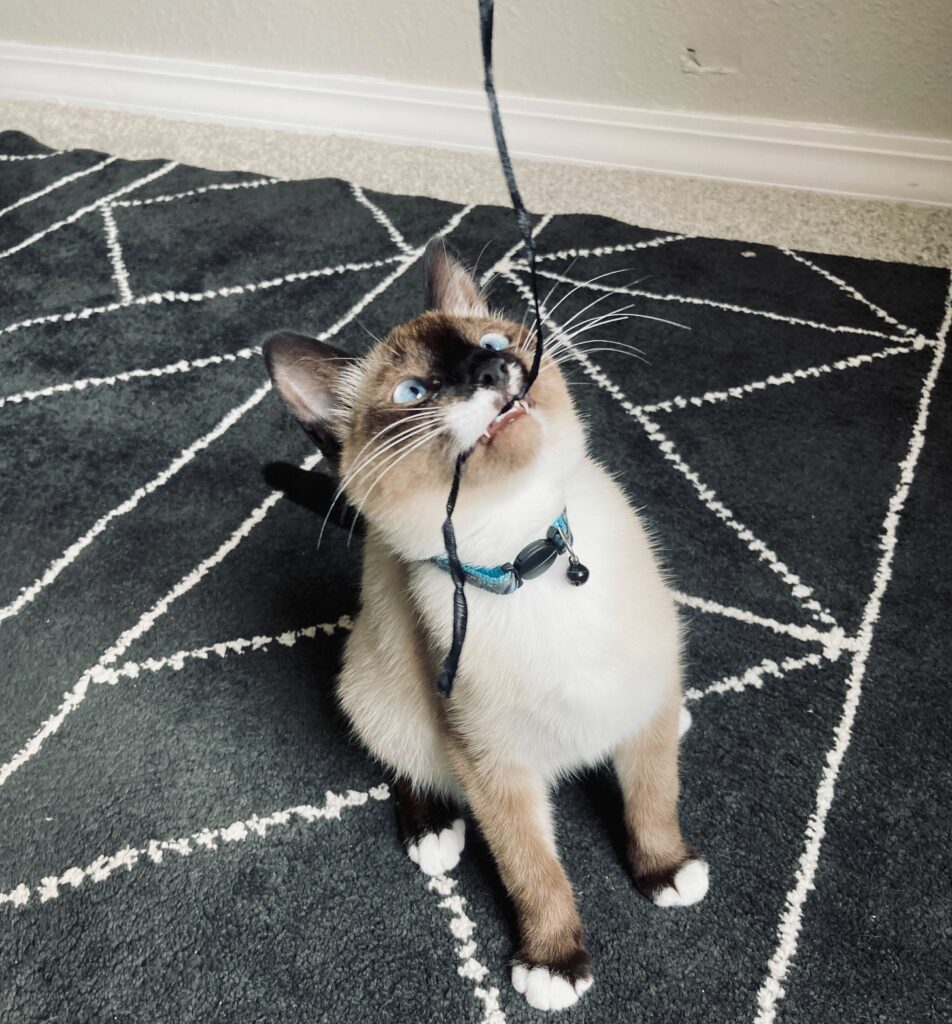Periodontal Disease in Cats: What You Need to Know
Keep your cat's teef healthy.

Keep your cat's teef healthy.

Gum disease is painful, expensive, and can lead to serious health outcomes for humans and cats alike. Fortunately, you can prevent periodontal disease in your cat relatively easily.
Focusing on keeping your kitty’s pearly whites healthy is simple, but it’s also important to know how to recognize the earliest stages of periodontal disease so you can get your cat treatment right away.
Periodontal disease, also called gum or dental disease, is a condition where bacteria and tartar in your cat’s mouth cause damage to important tissues.
The cat’s gums, ligaments, and bone can all be affected; as those structures are damaged, they aren’t able to support the teeth properly. As periodontal disease progresses, the teeth can become loose or even fall out because those support structures are so damaged.
Periodontal disease can be very painful, especially if the condition is advanced and causes significant damage to your cat’s mouth.
There are four stages of periodontal disease. The first stage is gingivitis, and the symptoms get increasingly painful, up to stage four. Gum separation increases with each stage, until stage four, when more than half of the gums are separated from the teeth and substantial bone loss occurs.
Take a breath. We know this is pretty nasty stuff. But all the more reason to know how to prevent it!
The symptoms of the early stages of periodontal disease include bad breath and inflammation of the gums. It can be difficult to spot these symptoms, especially if you’re not inspecting your cat’s mouth regularly. That’s why it’s important to make sure that your cat sees the vet for an annual wellness checkup, which includes an oral examination.
The periodontal disease symptoms increase in severity as the condition progresses, and may include:
If your cat’s gum disease progresses, they might increasingly have difficulty eating. You might notice personality changes, like increased irritability, because your cat is in pain. Poor baby.
Left untreated, periodontal disease can cause other serious health issues, including tooth root abscesses, and a condition called stomatitis where your cat’s mouth is so inflamed that they lose their appetite because of the pain.
Periodontal disease is caused by bacteria that naturally occurs in a cat’s mouth. That bacteria forms plaque along the gumline of the cat’s teeth. It only takes a few days for that plaque to harden into tartar, which becomes stuck on the teeth. Then, the bacteria works its way underneath the gums, where the bacterial infection causes inflammation.
That inflammation is called gingivitis, the first stage of periodontal disease. When a cat has gingivitis, the bacteria can gradually destroy the tissues that support the tooth.
If the gingivitis is left untreated, the periodontal disease progresses and leads to significant, painful symptoms that can include bleeding gums, loss of appetite, and tooth loss.
Periodontal disease is very common in cats. The Merck Manual notes that some cats can develop periodontal disease as early as one year of age.

Treatments for periodontal disease depend on how advanced your cat’s condition is.
It is likely that your vet will start with a full set of dental x-rays to determine the extent of the damage and the specific treatments that your cat needs.
If your cat is diagnosed with gingivitis, your vet will recommend a thorough dental cleaning. Your cat will be put under general anesthesia, and your vet will remove plaque and tartar from the teeth. Your vet will also clean any gaps between the gumline and the teeth, and will treat these areas with antibiotics to prevent infection and encourage those gaps to close up.
If your cat’s gum disease is more advanced, then your cat will still receive a dental cleaning, but your vet will recommend additional treatment options. Your vet may need to perform tooth extractions and surgery to clean and treat infected roots.
As you might imagine, these treatments and diagnostics can get expensive. The cost of the vet visit will depend on the specific treatments your cat needs, the clinic’s prices, and even your geographic location. If your vet refers you out to a veterinary dental specialist or surgeon for the treatment, then costs are likely to be higher, too.
Basic cat dental cleanings can start at around $200, but it’s easy for more complicated cleanings to cost $1,000 or more. Extractions and other surgeries will also increase your bill, and x-rays start around $250.
Luckily, Lemonade Pet health insurance offers a dental illness add-on. If you add this coverage, and your cat develops periodontal disease down the line, it can help cover the costs of treatments, procedures, diagnostics, and medications related to dental illness, including gingivitis and periodontal disease.
It can be frightening to think about your cat developing such a painful condition, but periodontal disease is also very preventable. Focusing on your cat’s oral health at home may help to avoid gum disease and potentially even reduce the number of dental cleanings your cat needs to receive at the vet.
Your home care should start with brushing your cat’s teeth. Yes, it sounds crazy at first, but with some patience and training, most cats can learn to have their teeth brushed.
Ask your vet to show you how to get started, then make a little time for teeth brushing training each day. With daily brushing, you can remove the plaque that contributes to gingivitis and the beginning of periodontal disease.
You don’t have to do all of the work with a toothbrush though. You can also use products like prescription dental diets for cats, dental water additives, and even tooth wipes. The Veterinary Oral Health Council maintains a list of accepted dental products for cats that can help you to get started, like toothpaste and dental treats and chews.

In addition to preventative measures at home, don’t forget to bring your cat to the vet for routine professional cleanings. Keeping up with these cleanings can help to prevent periodontal disease, and they also give your vet a chance to thoroughly examine your cat’s mouth for any other dental issues.
Lemonade offers several Preventative Care packages to help cover the costs of your cat’s ongoing care, like annual wellness exams and vaccines. Lemonade’s Preventative+ package will even help pay for your cat’s routine dental cleaning.
Periodontal disease can be very painful for cats, but thankfully it’s also relatively easy to prevent. When you focus on giving your cat quality dental care, you can catch and treat periodontal disease in its earliest stage, when it’s much easier and affordable to treat.
There are many ways to care for your cat’s dental health, and these preventative measures may mean that your cat never has to deal with gum disease. That’s catnip to our ears.
A few quick words, because we <3 our lawyers: This post is general in nature, and any statement in it doesn’t alter the terms, conditions, exclusions, or limitations of policies issued by Lemonade, which differ according to your state of residence. You’re encouraged to discuss your specific circumstances with your own professional advisors. The purpose of this post is merely to provide you with info and insights you can use to make such discussions more productive! Naturally, all comments by, or references to, third parties represent their own views, and Lemonade assumes no responsibility for them. Coverage and discounts may not be available in all states.
Please note: Lemonade articles and other editorial content are meant for educational purposes only, and should not be relied upon instead of professional legal, insurance or financial advice. The content of these educational articles does not alter the terms, conditions, exclusions, or limitations of policies issued by Lemonade, which differ according to your state of residence. While we regularly review previously published content to ensure it is accurate and up-to-date, there may be instances in which legal conditions or policy details have changed since publication. Any hypothetical examples used in Lemonade editorial content are purely expositional. Hypothetical examples do not alter or bind Lemonade to any application of your insurance policy to the particular facts and circumstances of any actual claim.